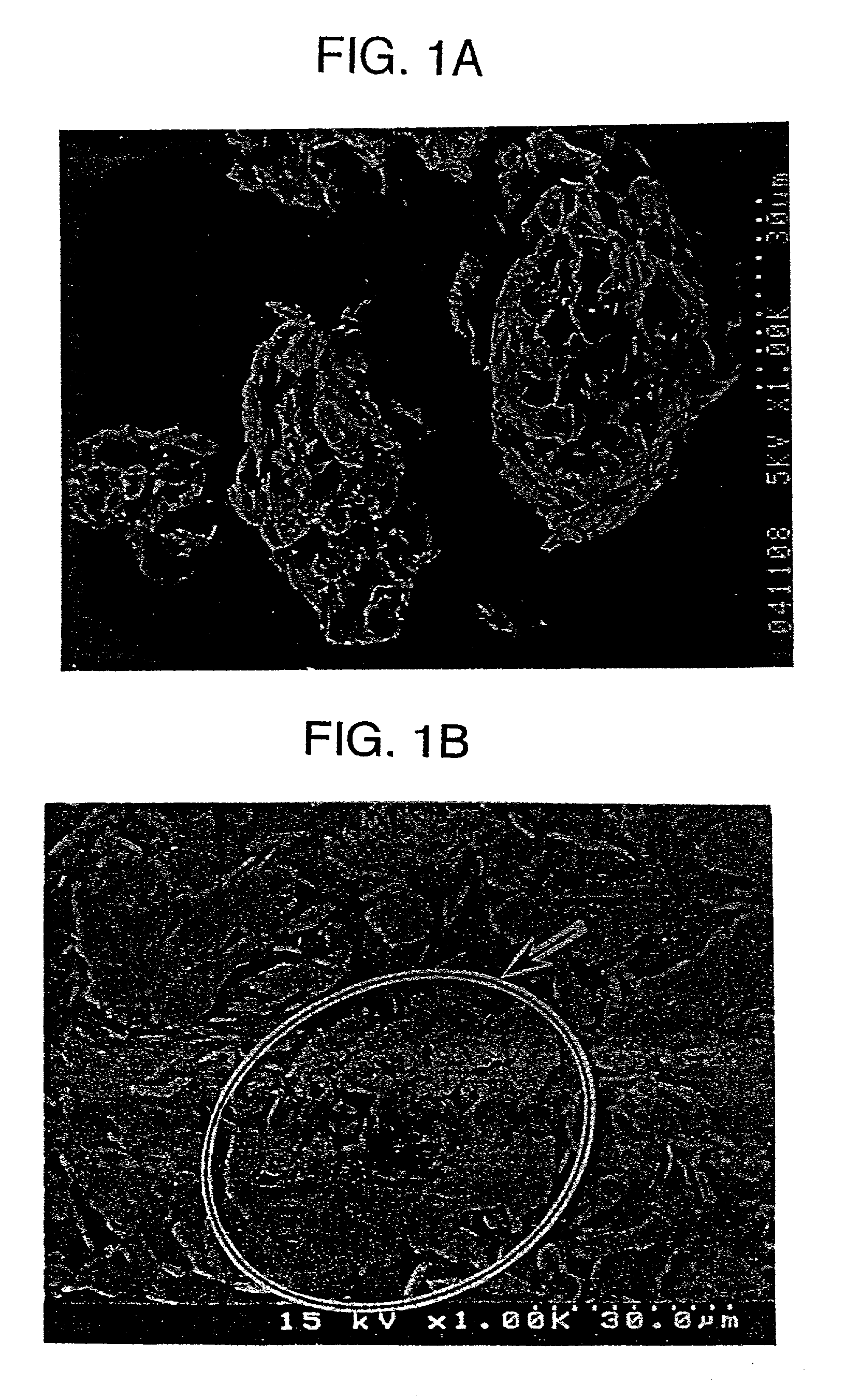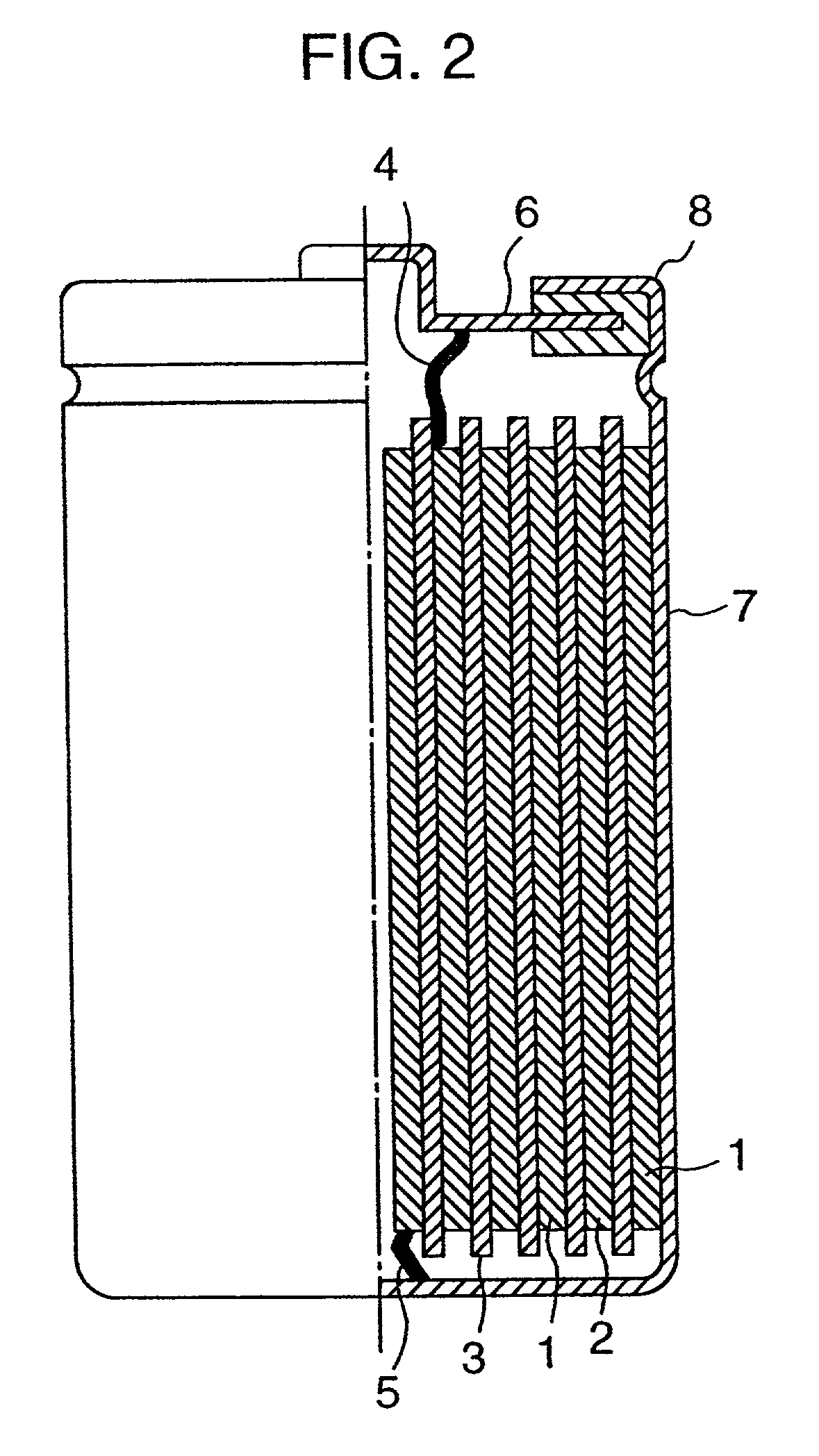Graphite particles and lithium secondary battery using the same as negative electrode
a lithium secondary battery and graphite technology, applied in the direction of cell components, final product manufacturing, sustainable manufacturing/processing, etc., can solve the problems of deteriorating cycle characteristics, internal breakage of electrodes, and affecting the quality of lithium secondary batteries, etc., to achieve excellent rapid charge-discharge characteristics and cycle characteristics, excellent in cycle characteristics, and small irreversible capacity of the first cycle
- Summary
- Abstract
- Description
- Claims
- Application Information
AI Technical Summary
Benefits of technology
Problems solved by technology
Method used
Image
Examples
example 1
[0096] (1) Preparation of Graphite Particles
[0097] Seventy parts by weight of coke powder having a mean particle diameter of 10 .mu.m, 20 parts by weight of tar pitch, 10 parts by weight of iron oxide and 20 parts by weight of coal tar were mixed together and stirred at 100.degree. C. for one hour. The mixture was calcined at 2,800.degree. C. in an atmosphere of nitrogen and then pulverized to obtain graphite particles having a mean particle diameter of 20 .mu.m. According to a scanning electron microscopic photograph (SEM photograph) of the graphite particles thus obtained, the graphite particles had a structure in which a plurality of flat-shaped particles were bound together so that the planes of orientation were not parallel to one another. One hundred particles were selected at random from the graphite particles thus obtained, and a mean value of their aspect ratios was measured. As a result, the mean value was 1.8. In a X ray broad angle diffraction of the graphite particles t...
example 2
[0104] Seventy parts by weight of coke powder having a mean particle diameter of 10 .mu.m, 10 parts by weight of tar-pitch, 2 parts by weight of iron oxide and 20 parts by weight of coal tar were mixed together and stirred at 100.degree. C. for one hour. Subsequently, the mixture was calcined in an atmosphere of nitrogen at 2,800.degree. C. and then pulverized to obtain graphite particles having a mean particle diameter of 20 .mu.m. An examination of the graphite particles thus obtained under an electron microscope revealed that a plurality of flat-shaped particles were assembled or bound together so that the planes of orientation thereof were not parallel to one another to form a graphite particle. One hundred particles were at random selected from the graphite particles, and mean value of aspect ratios thereof was determined to obtain a result of 4.8. X ray broad angle diffraction of the graphite particle thus obtained revealed that the interlaminar distance d (002) of the crystal...
example 3
[0106] A coke powder having a mean particle diameter of 20 .mu.m was calcined in an atmosphere of nitrogen at 2,800.degree. C. to obtain graphite particles having a mean particle diameter of 20 .mu.m. The graphite particles thus obtained constituted a flaky graphite having a mean aspect ratio of 6, a specific surface area of 11 m.sup.2 / g, an interlaminar distance d (002) in crystal of 3.365 .ANG. and a crystallite size Lc (002) of 800 .ANG..
[0107] The flaky graphite thus obtained was made into a lithium secondary battery via the same processes as in Example 1, and the battery characteristics thereof were examined in the same manner as in Example 1. The results are shown in FIG. 3 and FIG. 4.
[0108] The lithium secondary batteries obtained in Examples 1, 2 and 3 of this invention were compared with one another on occlusion and release of lithium. The results were as mentioned below. FIG. 3 is a graph illustrating the relation between discharge capacity and charge-discharge cycle numbe...
PUM
| Property | Measurement | Unit |
|---|---|---|
| aspect ratio | aaaaa | aaaaa |
| specific surface area | aaaaa | aaaaa |
| aspect ratio | aaaaa | aaaaa |
Abstract
Description
Claims
Application Information
 Login to View More
Login to View More - Generate Ideas
- Intellectual Property
- Life Sciences
- Materials
- Tech Scout
- Unparalleled Data Quality
- Higher Quality Content
- 60% Fewer Hallucinations
Browse by: Latest US Patents, China's latest patents, Technical Efficacy Thesaurus, Application Domain, Technology Topic, Popular Technical Reports.
© 2025 PatSnap. All rights reserved.Legal|Privacy policy|Modern Slavery Act Transparency Statement|Sitemap|About US| Contact US: help@patsnap.com



